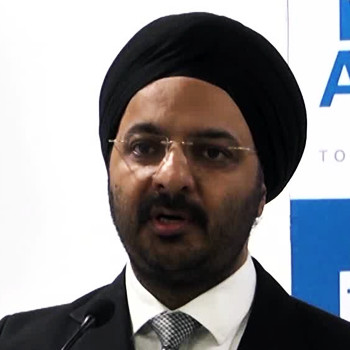
Dr Sarabjit Chadha leads the largest project The Union has ever undertaken – and it serves the country with the world’s greatest TB burden, India. Project Axshya’s mission is to strengthen TB control through civil society engagement and improve access to services for marginalised and vulnerable communities in 300 districts across 21 states. From his base at The Union South-East Asia Office in New Delhi, Dr Chadha manages the Axshya team of some 300 people working through a network of eight civil society partner organisations and thousands of volunteers. “This is the first time a civil society project on this scale has been implemented,” he says.
Funded by a US$ 30-million grant from the Global Fund to Fight AIDS, Tuberculosis and Malaria, Axshya completed its first five years in 2015 – and, due to its consistent success and “A” rating, it was funded to continue through 2017.
The project defined its target as 300 districts that were not performing well with regard to TB services. The model of working through civil society organisations and volunteers was new for The Union, but Dr Chadha and the other project planners agreed this was the best and most efficient way to reach people who needed the project’s aid – the poor, elderly, women and children, people with HIV and people living in hard-to-reach locations from mountain villages to urban slums.
“The partners are grassroots NGOs and community- and faith-based organisations,” says Dr Chadha. “When the project began in 2010, they were not experienced in working with the issue of tuberculosis, but they were expert in organising advocacy, communication and social mobilisation activities – and they knew the people in their areas well.”
The Union provided the partners with intensive training and works closely with them.
“Axshya covers a large geographic area and involves diverse partners, so to see it implemented – and to see the results – has been very exciting,” says Dr Chadha.
The scope of the programme sounds amazing, but Dr Chadha describes the project as “making an effort to leave a footprint,” so great are the size and complexity of India and the number of people involved.
For example, in 2015 the project established nearly 9,000 “Axshya Villages”. These are villages where residents have been sensitised about TB, the symptoms and how to diagnose and treat it. Following the sensitisation, the village receives a signboard declaring it an Axshya Village. “In some instances,” says Dr Chadha, “these villages may not have had a TB case for two or three years, but now they are aware. They know what to look for and what to do. The goal is to avoid diagnostic and treatment delays.”
Axshya volunteers help poor and isolated people with presumptive TB to get a diagnosis by providing a pick-up and delivery service that takes their sputum samples to the nearest TB laboratory and brings the results back. Often they travel hundreds of kilometers over difficult terrain by bicycle, motorbike, public transport and even boat, but, in 2015 they were able to deliver over 170,000 sputum samples, leading to the diagnosis of over 16,000 people with TB.
With logistics on this scale, Dr Chadha says “the first three years we were really building the systems. But the partners persevered, and we scaled up year by year, from 90 to 240 to 300 districts.” In 2013 they re-architected the project to focus on sputum collection and active case finding.
“The Global Fund has been a big supporter from the beginning,” he adds, and the extension of the project until 2017 is just the latest evidence of Axshya’s successful impact.
Dr Chadha brings more than 20 years of experience in working with TB and other lung diseases to his work for The Union, first as a clinician for a large social security organization serving industrial workers and their families and later as national drug-resistant TB consultant for the Revised National TB Control Programme (RNTCP) in India.
He first came into contact with The Union while he was working for WHO, when he took the MDR-TB course taught by Chen-Yuan Chiang and Pepe Caminero. Later he was part of the team that developed the Axshya grant, so he was particularly pleased to be selected to lead it.
In addition to Axshya, Dr Chadha has also led other projects during his five years at The Union: Project LIGHT, which brought LED microscopes into 200 Indian medical colleges greatly improving their TB diagnostic capacity; an Eli Lilly-funded project that facilitates notification and treatment adherence of TB patients in the private sector through mobile technology; and the seminal TB-diabetes bi-directional screening project conducted in collaboration with Jagran Pehel.
In 2010, he took The Union’s operational research course, which he credits for his now being the author of 25 papers. Building capacity for both TB and operational research are important to him, and one way he is facilitating that has been by bringing The Union’s TB, MDR-TB and OR courses to India. “It’s difficult for people to go to international courses, so we brought them here.”
He also teaches, acting as a facilitator for the MDR-TB courses, serves as the Union representative to the South East Asian regional MDR-TB advisory group (Green Light Committee) and provides technical assistance to the countries in the region.
With Axshya extended, the coming two years promise to be busy, but with over two million new TB cases annually in India, Dr Chadha is not planning to slow down. He is at work on another vital contribution to reducing his country’s TB burden: helping to launch the STREAM trial’s Phase II study of shortened MDR-TB treatment regimens in India.
“The global commitment is to end TB by 2035, and, largely, that means ending TB in India. We want to show that we are at the forefront of these efforts, and that India can achieve this goal.”
